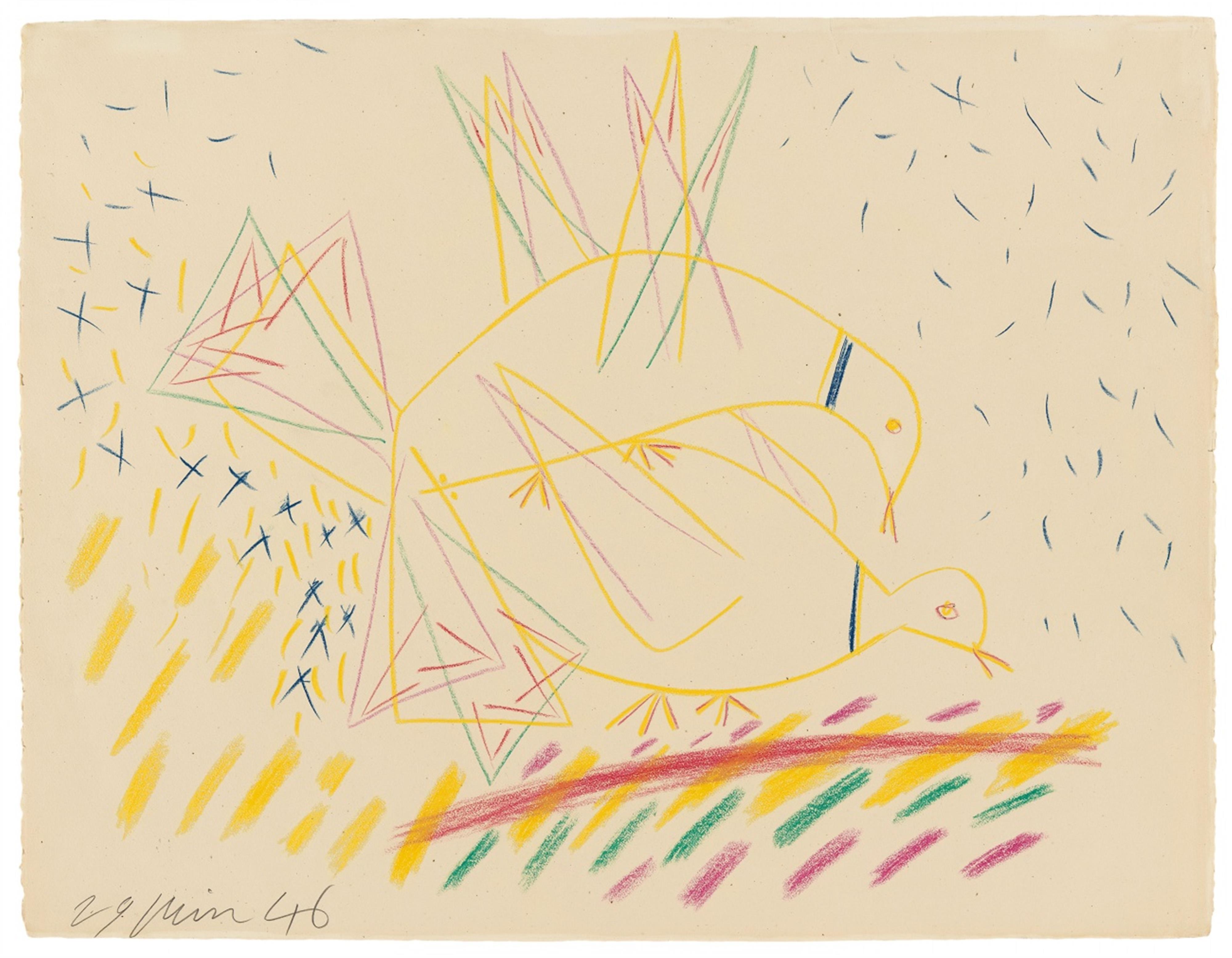Pablo Picasso
Deux Pigeons
1946
Coloured crayon drawing (wax crayons) on slightly grained laid paper with watermark "Arches" 50.5/50.7 x 65.5 cm Framed under glass. Unsigned. Dated '29 juin 46' in pencil lower left. - The paper overall slightly evenly browned with barely noticeable brighter light-stain along the edges; in fine condition.
The sights of everyday life have left virtually no trace in Picasso's work. To this extent the artist's occupation with these pigeons or doves, which are evidently in the process of mating, seems to form an exception. Of course Picasso has portrayed many types of creatures in drawings, paintings, sculptures and ceramic works, but are there any mating animals besides these pigeons? Perhaps he saw them while playing boules beneath the shady trees of the village square, or perhaps somewhere else, and observed their uninhibited doings.
Picasso has transformed the sensual pleasure experienced in looking at the pigeons around him into the elegance of geometricising contours and staccato-like strokes of colour; the charming X-shaped marks and accents form a wild rhythm and make the scene appear as though it were set to mesmerising music. The drawing of the pigeons is integrated into an abstract system of lines repeatedly utilised by Picasso to bring order to things. On that day of 29 June 1946 he created not just this emotional drawing in coloured chalk, but also additional repetitions of the theme in individual lithographs in red-violet and golden yellow or yellow and violet, which are printed on top of one another and provided with the appropriate title: “Les deux Tourterelles” or “Les Deux Tourterelles doubles”. The slight shift in the contour drawing can be seen in the two-tone print as well as here, in the coloured chalk drawing, and it emphasises the motif of the pigeons' tails and wings in a particularly lively manner, as if producing a simulation of movement.
Picasso's power of imagination is repeatedly a source of amazement, and it was nurtured not least by his profound bonds with his muses - in this period, Françoise Gilot, who would have an extraordinarily stimulating effect on the 65-year-old for over 10 years, beginning in May of 1943. This includes the “Françoise” portraits, lithographs created just a few days before our work, on 14 June 1946: a tremendously emotionally striking series ranging from a simple contour drawing to powerfully dense images in chalk. This chronological proximity tempts us to speculatively presume that Picasso was using these very blunt variations to also bring the goddess of love - Aphrodite or, alternatively, Venus - into play in both contexts, by means of the doves. Venus loved doves not only because they enriched the life of her temple, accompanied her through the air and - alongside Cupid - instigated the erotically charged process of falling in love, but also because tradition has it that they had once provided for her long ago, after fish had brought her from the sea to the land. Thus Picasso's “Pigeons” possess a mythological background, before which the grand master of the art of the 20th century has, through abstract forms, given direct and candid expression to a theme around which the world has always resolved.
Catalogue Raisonné
The Picasso Project 46-091; not recorded by Zervos (cf. however the drawings Zervos 177-182 of the same date with regards to the motif)
Provenance
Christie's London, Impressionist & Modern Watercolors & Drawings, 30 June 1987, lot 431; Stanley J. Seeger Collection, USA; Sotheby's New York, Seeger Collection 1993, lot 459; collection Switzerland
Literature
Alan Wofsy, Picasso's Paintings, Watercolors, Drawings and Sculpture. A Comprehensive Illustrated Catalogue 1885-1973, Volume: Liberation and Post-War Years 1944-1949. The Picasso Project, Alan Wofsy Fine Arts, San Francisco 2000, cat. no. 46-091, p. 89 with illus.

